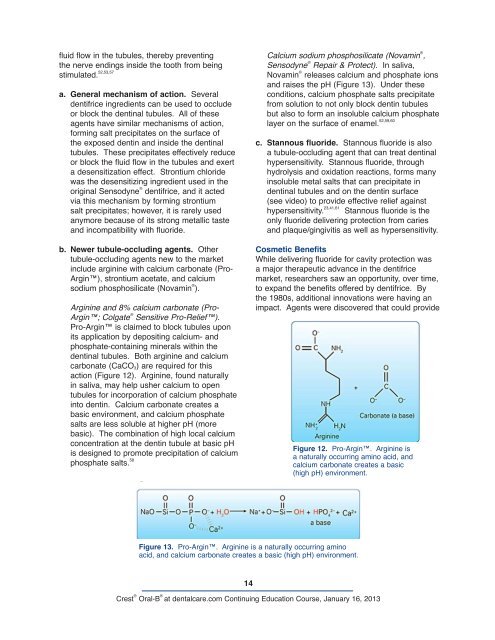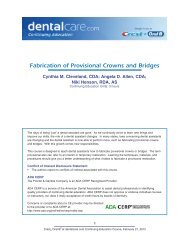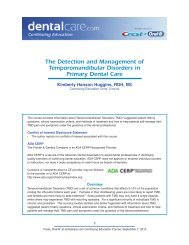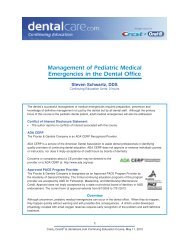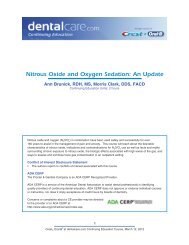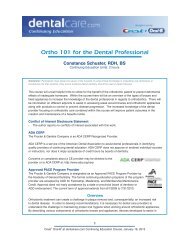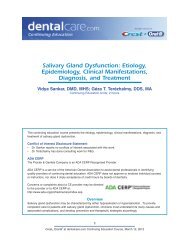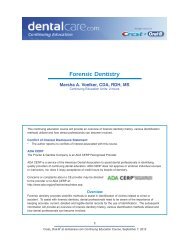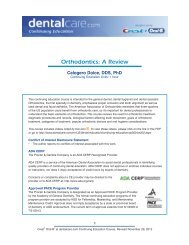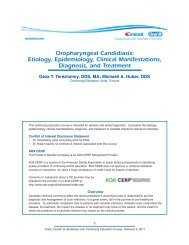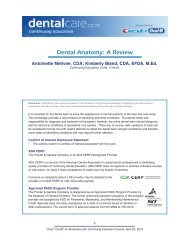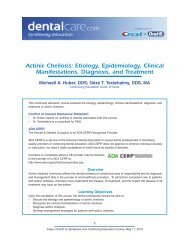CE410 - Fundamentals of Dentifrice: Oral Health ... - DentalCare.com
CE410 - Fundamentals of Dentifrice: Oral Health ... - DentalCare.com
CE410 - Fundamentals of Dentifrice: Oral Health ... - DentalCare.com
Create successful ePaper yourself
Turn your PDF publications into a flip-book with our unique Google optimized e-Paper software.
fluid flow in the tubules, thereby preventing<br />
the nerve endings inside the tooth from being<br />
stimulated. 52,53,57<br />
a. General mechanism <strong>of</strong> action. Several<br />
dentifrice ingredients can be used to occlude<br />
or block the dentinal tubules. All <strong>of</strong> these<br />
agents have similar mechanisms <strong>of</strong> action,<br />
forming salt precipitates on the surface <strong>of</strong><br />
the exposed dentin and inside the dentinal<br />
tubules. These precipitates effectively reduce<br />
or block the fluid flow in the tubules and exert<br />
a desensitization effect. Strontium chloride<br />
was the desensitizing ingredient used in the<br />
original Sensodyne ® dentifrice, and it acted<br />
via this mechanism by forming strontium<br />
salt precipitates; however, it is rarely used<br />
anymore because <strong>of</strong> its strong metallic taste<br />
and in<strong>com</strong>patibility with fluoride.<br />
b. Newer tubule-occluding agents. Other<br />
tubule-occluding agents new to the market<br />
include arginine with calcium carbonate (Pro-<br />
Argin), strontium acetate, and calcium<br />
sodium phosphosilicate (Novamin ® ).<br />
Arginine and 8% calcium carbonate (Pro-<br />
Argin; Colgate ® Sensitive Pro-Relief).<br />
Pro-Argin is claimed to block tubules upon<br />
its application by depositing calcium- and<br />
phosphate-containing minerals within the<br />
dentinal tubules. Both arginine and calcium<br />
carbonate (CaCO3) are required for this<br />
action (Figure 12). Arginine, found naturally<br />
in saliva, may help usher calcium to open<br />
tubules for incorporation <strong>of</strong> calcium phosphate<br />
into dentin. Calcium carbonate creates a<br />
basic environment, and calcium phosphate<br />
salts are less soluble at higher pH (more<br />
basic). The <strong>com</strong>bination <strong>of</strong> high local calcium<br />
concentration at the dentin tubule at basic pH<br />
is designed to promote precipitation <strong>of</strong> calcium<br />
phosphate salts. 58<br />
14<br />
Calcium sodium phosphosilicate (Novamin ® ,<br />
Sensodyne ® Repair & Protect). In saliva,<br />
Novamin ® releases calcium and phosphate ions<br />
and raises the pH (Figure 13). Under these<br />
conditions, calcium phosphate salts precipitate<br />
from solution to not only block dentin tubules<br />
but also to form an insoluble calcium phosphate<br />
layer on the surface <strong>of</strong> enamel. 52,59,60<br />
c. Stannous fluoride. Stannous fluoride is also<br />
a tubule-occluding agent that can treat dentinal<br />
hypersensitivity. Stannous fluoride, through<br />
hydrolysis and oxidation reactions, forms many<br />
insoluble metal salts that can precipitate in<br />
dentinal tubules and on the dentin surface<br />
(see video) to provide effective relief against<br />
hypersensitivity. 23,41,61 Stannous fluoride is the<br />
only fluoride delivering protection from caries<br />
and plaque/gingivitis as well as hypersensitivity.<br />
Cosmetic Benefits<br />
While delivering fluoride for cavity protection was<br />
a major therapeutic advance in the dentifrice<br />
market, researchers saw an opportunity, over time,<br />
to expand the benefits <strong>of</strong>fered by dentifrice. By<br />
the 1980s, additional innovations were having an<br />
impact. Agents were discovered that could provide<br />
Figure 12. Pro-Argin. Arginine is<br />
a naturally occurring amino acid, and<br />
calcium carbonate creates a basic<br />
(high pH) environment.<br />
Figure 13. Pro-Argin. Arginine is a naturally occurring amino<br />
acid, and calcium carbonate creates a basic (high pH) environment.<br />
Crest ® <strong>Oral</strong>-B ®<br />
at dentalcare.<strong>com</strong> Continuing Education Course, January 16, 2013


